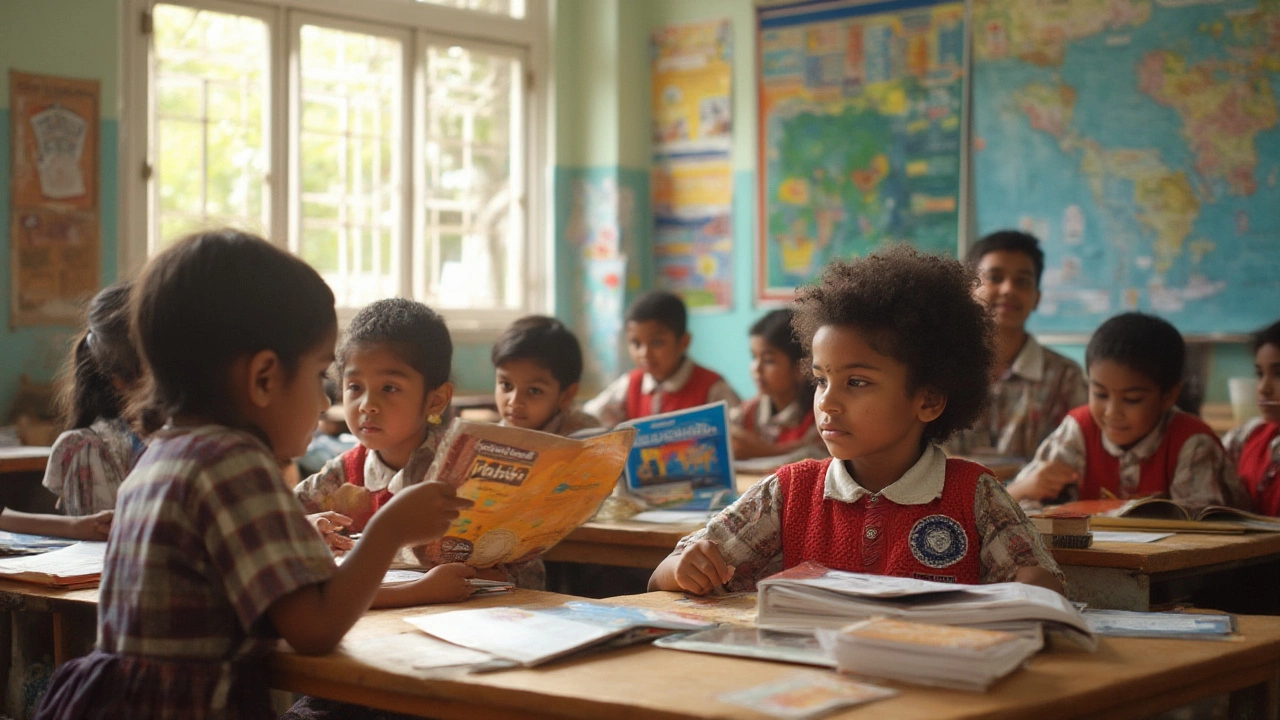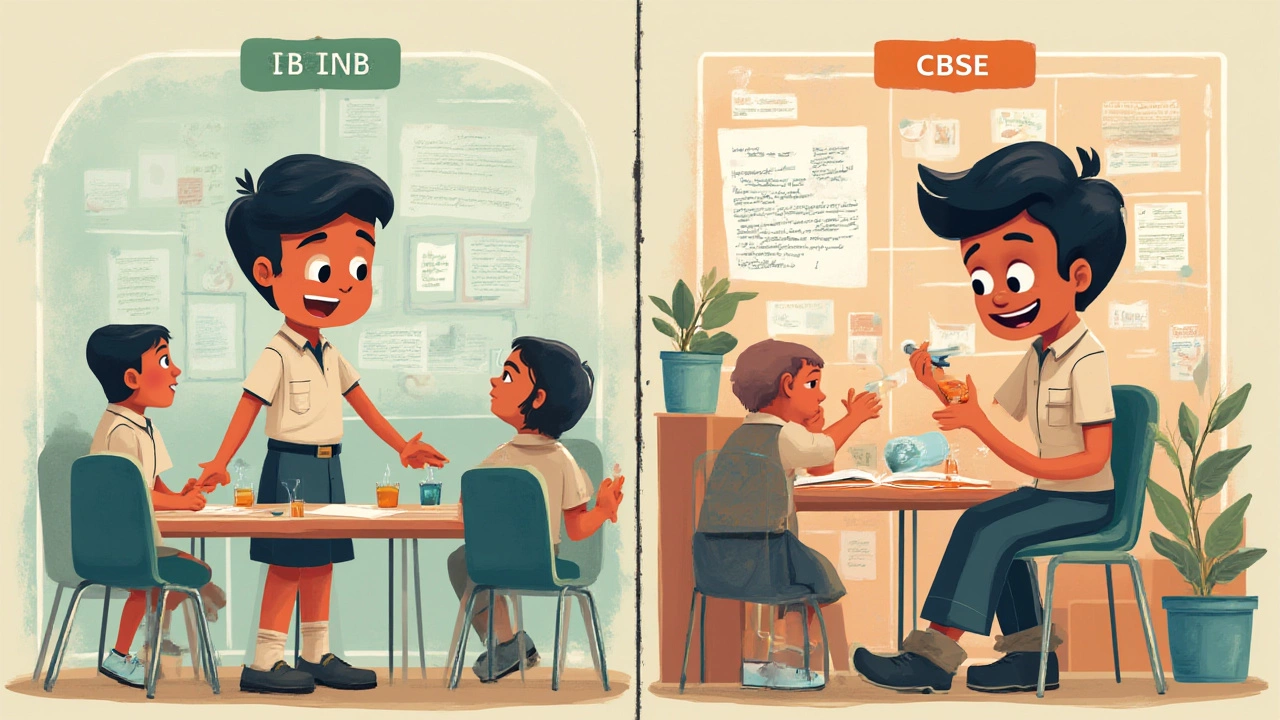Jul
9

- by Dhruv Ainsley
- 0 Comments
The debate over the "best" syllabus in the world is like the never-ending argument about pineapple on pizza. There’s no single answer—just strong opinions and a whole lot of passionate parents, students, and teachers. Education isn’t one-size-fits-all, and that’s glaringly obvious when you look at how different countries and boards build their learning roadmaps. But some syllabuses (yeah, "syllabi" works too) have gone global and are hotly debated. The International Baccalaureate, Cambridge IGCSE, India’s CBSE, US Common Core, and a few others spark conversations everywhere from dorm rooms to dinner tables. More than just what’s on the test, the syllabus you follow shapes your thinking, college options, and sometimes even your personality. Let’s get real about what actually matters when picking "the best," what data says about outcomes, and which system might make sense for you or your kids.
The Giants: Core Syllabuses Reshaping Global Education
Start with the big names and you’ll bump into the International Baccalaureate (IB), Cambridge Assessment International Education (aka IGCSE or A-Levels), Central Board of Secondary Education (CBSE), and the US Common Core. Each brings something different to the table, designed for particular countries but now inspiring classrooms all over the planet. Best syllabus is a phrase that pops up the most when you compare how these systems develop skills—not just raw knowledge.
The International Baccalaureate (IB) is perhaps the most talked-about. Born in Geneva in the 1960s, its core idea is preparing students for a global world, not just for one country’s college entrance exam. You get heavy doses of critical thinking, research, and even mandatory community service. IB schools exist in over 159 countries now, and more than 1.95 million students enrolled globally in 2024. Its famous "Theory of Knowledge" course isn’t about cramming facts but about learning how to learn and question assumptions—a skill recruiters drool over. The downside? It can be super intense, often requiring 6 subjects, plus a 4,000-word extended essay and those Creativity-Activity-Service hours (CAS). And IB-trained teachers aren’t always easy to find.
Then there’s the Cambridge IGCSE and A-Level path, which is essentially the global flavor of the British system. You’ll find Cambridge examinations in over 10,000 schools spread across 160 countries. The key appeal here is specialization. Want to drop History and focus on Math, Physics, and Chemistry? Done. You get flexibility to pick subjects, and the system pushes for depth rather than covering endless topics. The exam structure asks you to explain your thinking—you can’t skate by with just rote learning. No wonder top universities in the UK, US, Canada, and beyond know how to interpret these grades.
India’s CBSE and ICSE systems run thousands of schools, including prestigious ones across the Middle East, Africa, and Southeast Asia. CBSE shines for its focus on math and science, with the National Council for Educational Research and Training (NCERT) books often considered rigorous but student-friendly. There’s more focus on testing and grading than on project work, but reforms since 2020 are trying to push creativity, coding, and critical thinking. Want to ace the Joint Entrance Exam (JEE) for India’s elite tech schools? CBSE fits.
What about the American Common Core? This came in as an attempt to set a nationwide bar for literacy and math skills. The idea: no matter if you’re in Alabama or Alaska, you get the same skills and benchmarks. It’s widely adopted though still controversial; some states dropped out, and parents squabble over math word problems. US Advanced Placement (AP) programs also let high schoolers earn college credits, which is a huge plus for motivated teens. AP exams are now popping up outside the US too, especially in international schools.
Pay close attention to curriculum philosophy. The IB and IGCSE/A-Level ask for more essays, lab reports, presentations, and portfolio work. CBSE and Common Core prefer regular tests, quick assignments, and one big exam at the end. If your learning style leans toward hands-on projects and fewer multiple-choice questions, IB or Cambridge stands out. If you’re good at time management and nailing big exams, CBSE and US systems play to your strengths.
Here’s a side-by-side comparison for those who love the data:
| Curriculum | Founded | Countries (approx.) | Students (2024) | Main Focus |
|---|---|---|---|---|
| International Baccalaureate (IB) | 1968 | 159+ | 1.95 million | Inquiry, research, global perspective |
| Cambridge IGCSE/A-Level | 1858 | 160+ | ~8 million* | Subject depth, specialization |
| CBSE (India) | 1962 | 25+ (global hubs) | 34 million | Math/science, national exams |
| US Common Core/AP | 2010 (CC) | 50 states (partial) | ~16 million (CC), ~2.8 million (AP) | Skills benchmarks, early college credits |
*Estimate includes GCSE and A-levels worldwide
The difference, then, stems as much from national priorities as from method. IB readies you for debate, essays, big picture thinking. Cambridge is for the deep-divers and those who want some freedom. CBSE is direct, efficient, and math-forward. US systems love broad skills and options after grade 12. And still, you’ll spot curious blends—CBSE schools offering AP exams, IB students taking Indian coaching for JEE, and Cambridge candidates prepping for US colleges.

Real Impact: Universities, Skills, and Student Lives
Does your choice of syllabus really change your life? The honest answer: it depends on your goals and where you want to go. Let’s break down how colleges, employers, and the real world weigh each curriculum.
Universities across the world have gotten better at comparing results from these top syllabuses. Harvard, MIT, and Oxford know what an IB 42/45 or Cambridge 4A* means. Data from University College London showed that IB diploma holders are about 21% more likely to be admitted to top universities in the UK compared to A-Level students, mainly because of their broader skill set and essay experience. In the US, AP exam takers who score above 3 have a 72% higher chance of graduating college in four years, according to College Board studies.
The Cambridge and IB move you into college style learning faster. Extended essay? Sounds a lot like a real first-year research paper. Oral presentations and group projects give you a leg up with soft skills. And, with project-centered approaches now even entering CBSE and some US districts, there’s a visible trend toward adapting what works globally: skills, not just scores.
CBSE flies high in India but its brand is strongest within competitive exams like NEET, JEE, or UPSC. The curriculum’s thorough coverage of math and science matches textbook-heavy entrance tests, so students have a built-in advantage. There’s also a huge number of Olympiad winners and mathletes coming from this syllabus. But it can lack real-world and communications focus; something that’s changing with the new National Education Policy (NEP 2020), but only so fast.
Let’s talk about pressure. IB schools often warn parents—expect two hours of homework a night, loads of essays, and busy schedules. Some students thrive, but some end up burned out. Cambridge A-Levels let you drop weaker subjects, which is a relief for many. CBSE and US Common Core can get heavy, too, especially with final years focused only on exams. Each system tends to crank up the intensity as college application season comes around. Want to avoid stress? Schools in Finland, Denmark, or New Zealand use relaxed, progressive curricula that focus on creativity, play, and teamwork. These students do just as well (if not better) in life satisfaction indexes and innovation scores, according to 2023 OECD data.
Soft skills, critical thinking, and grit—employers care more about these than about memorized facts. In 2022, Google published a list of desirable traits for new hires: problem-solving, teamwork, communication, and time management beat "perfect recall" every time. The best syllabuses are the ones that weave these traits into daily learning. IB and Cambridge do a lot of this, but successful CBSE and US schools are catching up via coding clubs, Model United Nations, and project-based math competitions.
Is language a barrier? Cambridge and IB give you more flexibility to choose your exam language. This makes them a better fit for kids moving countries (or if you’re applying abroad). CBSE is mostly in English or Hindi, with less international mobility, though that’s changing as more Indians study overseas every year—the number of Indian students in US colleges hit an all-time high of 289,526 in 2024.
What about cost? IB and Cambridge both charge fees for exams, teacher training, textbooks, and school accreditation—sometimes thousands of dollars a year. CBSE and most US public schools are much lighter on the wallet. Choose wisely based on your family’s future plans and ability to pay. Scholarships exist, but aren’t unlimited.
Real-life tip: Don’t just pick the flashiest syllabus. Go see what projects, activities, alumni results, and support systems the school actually offers. Two IB or Cambridge schools can be worlds apart in teaching quality, extracurriculars, or counseling. If you want data, ask for alumni admission stats to major world universities or stable STEM jobs.

Choosing What Fits: Tips, Myths, and Unexpected Winners
Time to bust some myths. There is no global “gold medal” syllabus. Much depends on the individual. You have to match your personality, goals, and even your country’s future opportunities.
If you want to study or build a career abroad, IB and Cambridge IGCSE/A-Level make universities take notice. You’ll transition easily into Western teaching styles and have proof you worked across multiple subjects and projects. On the other hand, if you’re aiming at engineering, medicine, or government jobs in India or Southeast Asia, CBSE or ICSE aligns perfectly with competitive tests and state quota seats. US Common Core is your route if you’re in the US system; AP and SATs open doors everywhere but aren’t always easy to arrange outside the US.
Don’t ignore local options—or innovation. Finland’s system barely uses grades before age 15. Kids are encouraged to explore nature, art, problem-solving, and peer learning. Not flashy, but—Finland’s 2022 PISA science and reading scores are among the best in the world, with less stress and no national standardized tests before graduation. New Zealand and Singapore also blend local rigor with global skills, often topping innovation and literacy ratings.
A simple checklist helps:
- Think about where you want to study after school—home country or abroad?
- What subjects catch your interest and where are you strongest?
- Are you after flexibility and depth (Cambridge / IB) or a system built for standardized tests (CBSE / US)?
- Check whether teachers in your school really have deep training, or just follow the textbook. Quality matters far more than the label.
- Can your family handle IB or Cambridge fees? If not, look for scholarships, or choose strong public options with added coaching.
One thing is clear: the “best” syllabus is a moving target. Even the biggest boards adapt. IB adds digital literacy and entrepreneurship. Cambridge now pushes STEM clubs and coding. CBSE has started using AI modules and career skills training. US states are revamping Common Core to reduce test overload, building in project and peer learning. Schools that work closely with parents and regularly upgrade teacher skills will always have an edge, no matter what label sits atop their report cards.
To sum up, choosing a world-class syllabus isn’t about the brand, but what that brand delivers in your daily classroom experience. Balance your future plans with your learning style. Find out what universities, employers, and real-world data say—not just what’s on the school brochure. And, whenever in doubt, ask to talk to alumni who studied in that system. Nothing beats the truth straight from the people who lived it.





